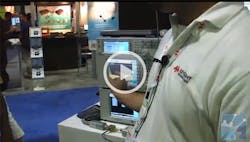How Do Real-Time Spectrum Analyzers Work?
In the Engineering TV video above, Agilent Technologies’ Raidh Said talks to STEM high-school students about real-time spectrum analyzers.
Although traditional instruments like swept spectrum analyzers (SSAs) and vector signal analyzers (VSAs) deliver snapshots of signals in frequency and modulation domains, RF measurements still face multiple challenges. They include weak signals being masked by stronger ones, observing signals masked by noise, finding/analyzing transient and dynamic signals, and capturing spread-spectrum and frequency-hopping signals, among others.
Real-time spectrum analyzers (RTSAs) work to overcome these challenges by using real-time digital signal processing (DSP) to perform signal analysis. This occurs prior to memory storage, as opposed to the post-acquisition processing present in typical VSA architectures. Thanks to real-time processing, users are able to discover events that are invisible to the other architecture—data is then used to analyze multiple domains in batch processing. Such processing also can perform signal conditioning, calibration, and other forms of analysis.
Real-time engines used in RTSAs open the door to a host of other features: real-time correction for analog-signal-path imperfections; triggering in the frequency domain with frequency mask trigger (FMT); triggering on user-specified bandwidths with filtered power trigger; real-time demodulation that allows users to listen to particular signals within a busy band; and digital IQ streaming of digitized data, leading to uninterrupted output of signals for external storage and processing. Performing these signal-processing tasks repetitively allows for the freeing up of valuable software-based resources.
Also be sure to check out other videos from IMS 2014 over at Engineering TV.
Information for this article was found in the Tektronix white paper, “Real-Time Spectrum Analyzer Fundamentals.”
